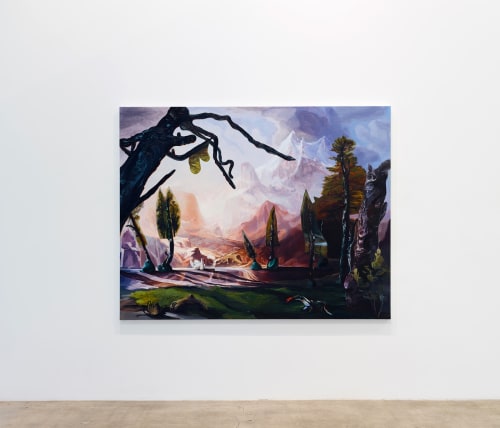In Arcadia, Emma Webster, a recent Yale MFA, creates landscape paintings that are a melange of styles and iconographies. She draws from historic painters like Bosch and Bierstadt to juxtapose their expansive, idyllic views and sense of scale and space with depictions of plastic foliage and quirky animal figurines. Webster begins by making small-scale tableaux and dioramas which she then translates into large-scale oil paintings. The fifteen works encapsulate a post modern interpretation of Arcadia that is more of a pastiche than something familiarly bucolic. Still Life (all works 2018) is a surreal environment with colorful rolling hills populated by a range of animals and figures each presented in isolation and having very little to do with each other. In the foreground an expressively painted bull gazes at or past a larger than life rabbit. The sight line ends at a young child standing in the shadow of a leaning tree. It is hard to discern what the people within this world are doing, Are they farmers? Travelers? Nested in the hills is an American flag. It is surrounded by an expanse of green. A figure painted in white tones dangles from the top of the composition amongst clouds and a small few birds. Fake-looking trees dot the landscape appearing as if cut from a different scenario. The composition is a series of horizontal striations that move from dark (earth) to light (sky) filled with different species who could not co-exist in reality.
Park Service is a similarly enigmatic and ambiguous landscape with snow-filled mountainous peaks in the distance. A white swan floats toward the center hovering above what appears to be a body of water. Trees whose leaves appear to be contained in plastic bags emanate from blue rocks and cast dramatic shadows onto the ground. A fire breathing creature guards the foreground. A darkly painted large tree leans in from the left side of the frame, its anthropomorphized branches casting an ominous aura onto the environment.
Webster’s way of handling paint fluctuates from the representational to the abstract and she has a knack for mixing styles within each painting. Some aspects of the works are rendered with exacting detail while at other times a few dabs of paint are all she needs to depict a living organism. An Aside presents a receding seascape. Gestural abstractions sign for tree-tops before a sky that transitions from blue to light orange as it meets a deep green plane. Is the ‘aside’ the human element— two figures— a woman washing the foot of a man by the water in the foreground, or the post apocalyptic tenor of the landscape.
Webster’s Arcadia is hardly utopian. Her landscapes are places where animals run wild, trees have a plastic sheen and the color of day and night is slightly off putting, as if something catastrophic was about to happen or just happened. The paintings call attention to our changing climate and present what is, as well as what could be if we let things get out of control.

